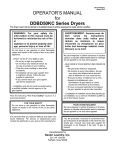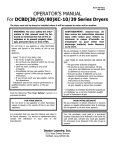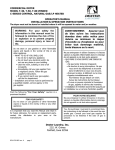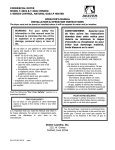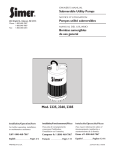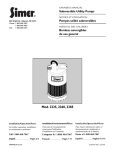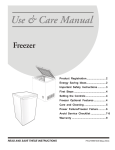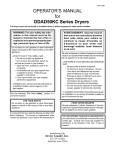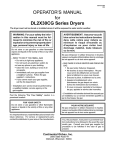Download Dexter Laundry COIN COMPACT DRYER Operator`s manual
Transcript
8514-046-001F July 2013 OPERATOR’S MANUAL for COIN COMPACT DRYER The dryer must not be stored or installed where it will be exposed to water and/or weather. WARNING: For your safety the information in this manual must be followed to minimize the risk of fire or explosion or to prevent property damage, personal injury or death. -Do not store or use gasoline or other flammable vapors and liquids in the vicinity of this or any other appliance. -WHAT TO DO IF YOU SMELL GAS -Do not try to light any appliance. -Do not touch any electrical switch: do not use any telephone in your building. -Clear the room, building or area of all occupants. -Immediately call your gas supplier from a neighbor’s telephone. Follow the gas supplier’s instructions. -If you cannot reach your gas supplier, call the fire department. Installation and service must be performed by a qualified installer, service agency or the gas supplier. You, the purchaser, must post in a prominent location instructions to be followed in the event the user smells gas. Consult your local gas supplier for procedure to be followed if the odor of gas is present. Post the following “For Your Safety” caution in a prominent location: FOR YOUR SAFETY Do not store or use gasoline or other flammable vapors or liquids in the vicinity of this or any other appliance. FOR YOUR SAFETY THIS MACHINE IS FOR DRYING ONLY FABRICS CLEANED IN WATER. To avoid possibility of fire, including spontaneous combustion, do not dry oiled floor mops, items containing foam rubber or similarly textured rubberlike materials or any material on which you have used a cleaning solvent or which contains flammable liquids or solids (such as gasoline, kerosene, waxes, etc.) It is important that you read this Manual and retain it for future reference. For service or replacement parts, contact the distributor in your area or: Dexter Laundry, Inc 2211 W. Grimes Fairfield, Iowa 52556, USA French Language Warnings AVERTISSEMENT. Assurez-vous de bien suivre les instructions données dans cette notice pour réduire au minimum le risque d’incendie ou d’explosion ou pour éviter tout dommage matériel, toute blessure ou la mort. Ne pas entreposer ni utiliser d’essence ni d’autres vapeurs ou liquides inflammables dans le voisinage de cet appareil ou de tout autre appareil. I. QUE FAIRE SI VOUS SENTEZ UNE ODEUR DE GAZ: · · · · · Ne pas tenter d’allumer d’appareil. Ne touchez à aucun interrupteur. Ne pas vous servir des téléphones se trouvant dans le bâtiment oú vous vous trouvez. Évacuez la pièce, le bâtiment ou la zone. Appelez immédiatement votre fournisseour de gaz depuis un voisin. Suivez les instructions du fournisseur. Si vous ne pouvez rejoindre le founisseur de gaz, appelez le service des incendies. L’installation et l’entretien doivent être assurés par un installateur ou un service d’entretien qualifié ou par le fournisseur de gaz. POUR VOTRE SÉCURITÉ Ne pas enteposer ni utiliser d’essence ni d’autres vapeurs ou liquides inflammables dan le voisinage de cet appareil ou de tout autre appareil. 2 TABLE OF CONTENTS Page No. Warnings about use and operation ...................................................................................... 3 Installation Instructions ................................................................................................5, 6, 7 Dryer Shutdown .................................................................................................................10 Operating Instructions.........................................................................................................11 Preventative Maintenance Instructions................................................................................16 ILLUSTRATIONS Figure 1 - Dryer Dimensions .................................................................................................4 Figure 2 - Vertical Clearance Dimensions ............................................................................6 Figure 3 - Dryer Exhausting ..................................................................................................9 WARNINGS ABOUT USE AND OPERATION It is ABSOLUTELY ESSENTIAL that the dryer be grounded to a known earth (zero) ground. This is not only for personal safety, but is necessary for proper operation. KEEP SHIELDS, GUARDS AND COVERS IN PLACE. These safety devices are provided to protect everyone from injury. A DRYER SHOULD BE CONNECTED TO POWER FOR THREE (3) MINUTES before it is operated or before a program change is made. Operation or program changes, which occur during this "power up" period, are subject to loss in case of power interruption. After the initial three minutes, all programmed data is protected from power interruptions of any length and the customer's individual cycle is protected up to 3 seconds. This is done without batteries. LEAVE THE ELECTRICAL POWER TO THE DRYER ON AT ALL TIMES except when necessary for service or other similar activities. The hour meter function adds only full hours to its reading. If the power is shut off every night, any fraction of an hour of time that is on the machine at that time will be lost. Turning the power off every night could also have some effect on the long-term life of the memory after a number of years. Turning power off occasionally won’t affect the unit. THIS DRYER IS EQUIPPED WITH A MANUALLY RESETTABLE OVERTEMPERATURE THERMOSTAT located on the end of the burner housing below the gas valve. Should the dryer cease to heat, reset the thermostat by inserting a wooden (nonconductive) pencil or dowel through the guide bushing in the cover. Should the thermostat continue to trip, the dryer must be inspected by a qualified service person. CHECK THIS THERMOSTAT WHEN INSTALLING DRYER to assure it is not tripped. Impacts, such as rough handling in shipment, may trip the thermostat. It may be reset by inserting a wooden (nonconductive) pencil or dowel through the guide bushing in the cover. 3 4 INSTALLATION AND OPERATING INSTRUCTIONS This dryer may have been supplied as part of a washer/dryer stacked appliance. If so, refer to the washer instructions for uncrating and hard mounting the stacked unit to a concrete floor and observe the dryer clearances listed below. UNCRATING AND PLACING DRYER (Stand alone dryer unit): Tools Required: ½ in. hex socket and ratchet driver, wood block 4 in. or 5 in. (102-127 mm) thick, a knife and a groove joint pliers, which will open to 1 3/8 in. (35 mm). 1. Remove and discard stretch-wrap, posts, cap and inner packing. 2. The crate base is attached to the dryer by (4) cap screws driven upward from below the crate base. Remove crate base from dryer, by tipping dryer sidewise and place block under crate base rail in center of dryer. Using a ratchet and ½ in. hex socket, remove and discard (2) crating bolts from side, which is raised. Remove block from under crate base. Repeat for other side. 3. Install the leveling legs, which are shipped inside the dryer drum. Using a walking motion, move dryer sideways about 6 in. (152 mm) off crate base. Tip dryer up and place block under edge of dryer. Thread two leveling legs about two-thirds into the T-nuts on the base from which the crating bolts were removed. Remove block from under dryer. With a walking motion move dryer completely off crate base. Discard crate base. Tip dryer sidewise, as previously done, and place block under edge of dryer on raised side. Thread leveling legs into nuts as was done for the first side. Slide unit into position where it will be installed. Adjust leveling legs, using the groove joint pliers, to level and align dryer with adjacent units. DRYER INSTALLATION 1. CODE CONFORMITY: All commercial dryer installations must conform to the local and national codes for the location of installation. 2. INSTALLATION CLEARANCES: This unit may be installed at the following alcove clearance. I. Left Side 0 II. Right Side 0 III. Back 18 in. (457 mm) clearance is necessary behind the motors to allow servicing and maintenance. IV. Front 48 in. (1220 mm) to allow use of dryer. 5 V. Top VI. Floor Refer to figure labeled “Vertical Clearance Dimensions”. AB. 0 clearance is allowable at the top; 4 in. (102 mm) back from the front. However 1/4 in. (6 mm) clearance should be allowed in case the dryer needs moving. C. 10 in. (254 mm) clearance is required from top at all other points. If used as a stand alone dryer, this unit is intended to be installed upon an elevated surface. The surface must be of suitable strength to support 450 pounds (205 kg), and the dryer should be bolted or anchored to prevent horizontal movement. The dryer may be installed upon a combustible surface. Refer to the label attached to the Belt Guard on the rear of the dryer for other installation information and start-up instructions. 6 3. MAKE-UP AIR. Adequate make-up air, 440 CFM (12.5 m3/min.), must be supplied to replace air exhausted by dryers on all types of installations. Provide a minimum of 1 sq. ft. (.14 m2) make-up air opening to outside for each dryer. This is a net requirement of effective area. Screens, grills or louvers, which will restrict the flow of air, must be considered. Consult the supplier to determine the free area equivalent for the grill being used. The source of make-up air should be located sufficiently away from the dryers to allow an even airflow to the air intakes of all dryers. Multiple openings should be provided. NOTE: The following considerations must be observed for gas dryer installation where dry cleaners are installed. The sources of all make-up air and room ventilation air movement to all dryers must be located away from any dry cleaners. This is necessary so that solvent vapors will not be drawn into the dryer inlet ducts. Dry cleaner solvent vapors will decompose in contact with open flame such as the gas flame present in clothes dryers. The decomposition products are highly corrosive and will cause damage to the dryer(s) ducts and clothes loads. 4. ELECTRICAL REQUIREMENTS. The electrical power requirements necessary to operate the unit satisfactorily are listed on the serial plate located on the back panel of each dryer. The electrical connection should be made to the terminal board, on the rear of the unit in the upper control box using copper conductors of 15A minimum capacity. It is absolutely necessary that the dryer be grounded to a known (earth) ground. The installation must meet the National Electrical Requirements of the country of installation. Individual 15A circuit breakers for each dryer are required. The installer must provide a disconnect switch which will interrupt both lines. It may be a local or national requirement to provide an electrical interruption switch visible and accessible from the room in which the dryer is installed. The wiring diagram is located on the belt guard on the back of the dryer. 5. GAS REQUIREMENTS. The complete gas requirements necessary to operate the dryer satisfactorily are listed on the serial plate located on the back panel of the dryer. The inlet gas connection to the unit is ½ in. NPT pipe thread. However, the size of the piping to supply the dryer should be determined by reference to national installation practice and consultation with the local gas supplier. A joint compound resistant to all fuel gases must be employed in making threaded pipe connections. A drip tee should be provided in the unit gas piping to catch dirt and other foreign articles. All pipe connections should be checked for leakage with soap solution. Never check with an open flame. 7 CAUTION: The dryer and its individual shutoff valve must be disconnected from the gas supply piping system during any pressure testing of that system at test pressures in excess of ½ psig (35 mbar). The dryer must be isolated from the gas supply piping system by closing its individual manual shutoff valve during any pressure testing of the gas supply piping system at test pressures equal to or less than ½ psig (35 mbar). 6. EXHAUST INSTALLATION. (Refer to Figure 3 at the end of section 6.) Exhausting of the dryer(s) should be planned and constructed so that no air restrictions occur. Any restriction due to pipe size or type of installation can cause slow drying time, excessive heat, and lint in the room. From an operational standpoint, incorrect or inadequate exhausting can cause a cycling of the high limit thermostat, which shuts off the main burners and results in inefficient drying. Individual exhausting of the dryers is recommended. All heat, moisture, and lint should be exhausted outside by attaching a pipe of the proper diameter to the dryer adapter collars and extending it out through an outside wall. This pipe must be very smooth on the inside, as rough surfaces tend to collect lint, which will eventually clog the duct and prevent the dryer from exhausting properly. All elbows must be smooth on the inside. All joints must be made so the exhaust end of one pipe is inside the next one downstream. The addition of an exhaust pipe tends to reduce the amount of air the blower can exhaust. This does not affect the dryer operation if held within practical limits. For the most efficient operation, it is recommended that no more than 14 ft. (4.25 m) of straight 6 in. (152 mm) diameter pipe with two right angle elbows be used for each cylinder. If the exhaust pipe passes through a wall, a metal sleeve of slightly larger diameter should be set in the wall and the exhaust pipe passed through this sleeve. This practice is required by some local codes and is recommended in all cases to protect the wall. This type of installation should have a means provided to prevent rain and high winds from entering the exhaust when the dryer is not in use. A hood with a hinged damper can be used for this purpose. Another method would be to point the outlet end of the pipe downward to prevent entrance of wind and rain. In either case, the outlet should be kept clear, by at least 24 in. (610 mm) of any objects, which would cause air restriction. Provide a screen or grill over the termination of the exhaust or flue outlet such as will prevent the entry of a ball of 5/8 (16 mm) in diameter while the machine is not operating but will allow entry of a ball 1/4 (6 mm) in diameter while operating. When exhausting a dryer straight up through a roof, the overall length of the duct has the same limits as exhausting through a wall. A rain cap must be placed on top of the exhaust and must be of such a type as to be free from clogging. The type using a cone shaped “roof” over the pipe is suitable for this application. Exhausting the dryer into a chimney or under a building is not permitted. In either case there is a danger of lint buildup, which can be highly combustible. 8 Installation of several dryers, where a main discharge duct is necessary, will need the following considerations for installation (see Figure 3). Individual 6 in. (152 mm) exhaust ducts from the each dryer should enter main discharge duct at a 45-degree angle in the direction of discharge airflow. NOTE: Never install the individual ducts at a right angle into the main discharge duct. The individual ducts from the dryers can enter at the sides or bottom of the main discharge duct. Figure 3 indicates the various round main duct diameters to use with the individual dryer ducts. The main duct can be rectangular or round, provided adequate airflow is maintained. The total exhausting (main discharge duct plus duct outlet from the dryer) should not exceed the equivalent of 14 ft. (4.5 m) and two elbows. The diameter of the main discharge duct at the last dryer must be maintained to exhaust end. NOTE: A small diameter duct will restrict airflow; a large diameter duct will reduce air velocity - both contributing to lint build up. An inspection door should be provided for periodic clean out of the main duct. 9 7. DRYER IGNITION (SOLID STATE IGNITION). The solid-state ignition system lights the main burner gas by spark. The gas is ignited and burns only when the gas-valve relay (in the electronic controller) calls for heat. The procedure for first-time starting of a dryer is as follows: A. First, review and comply with the “WARNINGS ABOUT USE AND OPERATION” found on the inside front cover of this manual. Be sure the electrical power supply is connected correctly. The dryer MUST be properly grounded. B. Make sure all gas supply lines are purged of air. Close the main gas shut-off valve and wait for five minutes before turning the valve back on. C. Turn on the main electrical power switch. The dryer may be started by following the “OPERATING INSTRUCTIONS” found later in this manual. D. Natural gas and liquefied petroleum gas fired dryers both operate in the same manner. When the gas-valve relay contacts are closed (indicating a demand for heat), the solid-state ignition control will automatically supply energy to the redundant gas valve. Spark will continue until a flame is detected by the sensing probe, but not longer than 10 seconds. If the gas fails to ignite within 10 seconds, the gas will shut off for 15 seconds. The control will attempt to ignite two more times in a similar manner. If the gas fails to ignite after three tries, the gas valve closes and the system will “lock out”. No further attempts at ignition will be performed automatically. It is then necessary to interrupt electrical power to the ignition system before making another attempt at igniting the burners. This can be done by opening the dryer door, allowing the dryer to come to a stop for 15 seconds, closing the door, and pushing the Start button. The dryer will then repeat the ignition trial cycle. DRYER SHUTDOWN To render the dryer inoperative, turn off the main gas shut-off valve and disconnect electrical power to the dryer. 10 OPERATING INSTRUCTIONS 1. Deposit coins to satisfy vend price display of idle dryer. Each deposit decreases the vend price until the display changes to show the amount of time purchased. WARM or LOW light illuminates. 2. Select drying cycle. Other cycle selections may be made now or later by pressing the appropriate key (button). 3. Close the loading door. Press “START” and the dryer will start. The time remaining is displayed in whole minutes (rounded up) and will count down each minute. 4. Clothes should be removed promptly after the cycle is completed to prevent excessive wrinkling. Once started, the “timer” cannot be stopped. However, extra coins will be acknowledged by adding time to the display. The dryer may be stopped by opening the loading door, which interrupts the drive motor and gas burners. Close the loading door and push “START” to restart the dryer. Cool-down time (owner programmable) is always part of the cycle time and is purchased by the customer. For example, if cool-down time is 2 minutes, the last two minutes of the cycle will have no heat. DESCRIPTION OF CONTROLS Credit for coins deposited, dryer time and temperature are controlled by an electronic control. The large digital display shows vend price of an idle dryer, time purchased after coins are deposited, temperature, and program information. The three red indicator lights show the drying temperature selected. This selection may be made anytime. The drying temperature will be displayed when the start switch and the switch for selected temperature are pressed at the same time. All programmed data is protected from power interruption of any length, and the customer’s cycle is protected for up to 3 seconds. This is done without batteries. The 3 temperature buttons and the start button become programming switches when the controller is in the program mode as described below. 11 PROGRAMMING: All operating parameters (vend price, temperatures, cool-down times, etc.) are adjustable. There are also several displays of information available from the controller (money audits, hours run, and dryer temperature.) The dryer is shipped ready for operation with the following pre-programmed data: Temperature- HOT (or HIGH): Temperature- MEDIUM: Temperature- WARM (or LOW): Vend Price: Time for Left Coin Slot: Time for Right Coin Slot: Time for Free Vend: Cool-down Time HOT (or HIGH): Cool-down Time MEDIUM: Cool-down Time WARM (or LOW): Temperature Scale: Decimal Point Display: Seconds on Display: 175°F/ 78°C 150°F/ 63°C 125°F/ 48°C 25¢ 3:20 (does not apply to single coin models) 8:00 (8 minutes for 25¢) 8:00 2:00 2:00 2:00 °F ON OFF All of the above data can easily be changed by the owner. The changes are made by the 4 keys or buttons on the front of the control panel. CHANGING PROGRAM DATA Put dryer in PROGRAM mode (see “Programming Instructions”). The dryer remains in the PROGRAM mode until one of these actions occur: · · The switch is actuated again. The seventeenth step is completed, and the START switch is pushed following the seventeenth step. Programming is stopped for about a minute. The loading door is closed. · · · Observe the displayed value in each step. If no change is required, press START to advance to the next program step. If a change is required the values are made larger by the HOT (or HIGH) button, smaller by the MED button. The hour meter and money audit can be reset to zero if WARM (or LOW) is pressed. Note: After any reset or program change, it is necessary to advance to the next step by pressing START to enter the revision. OTHERWISE THE VALUE WILL REMAIN AS IT WAS BEFORE THE ALTERATION. 12 TO CHANGE PROGRAMMED VALUES OR ZERO REGISTERS 1. Open the loading door. 2. Unlock the control tray, carefully slide the control tray assembly forward about three inches. Press the program switch. (See Figure 4 “Top View of Controller”) Reinstall and lock the controller. The controller is now in the program mode at the “00" step, displaying the hours run by the lower drum. (Refer to the table defining the steps.) This value displayed can be reset to “0" or observed and left as is: Pressing the START switch will advance the controller through the fifteen remaining steps allowing observation or alteration. Note that on any program change or reset it is necessary to advance to the next step by pressing the START switch to enter the revision. Otherwise the value will remain as it was before the alteration. Figure 4 - Top View of Controller 13 ORDER OF PROGRAMMING STEPS CYCLE LIGHTS DISPLAY HOT or HIGH MEDIUM WARM or LOW __ __ PROGRAMMING STEP DESCRIPTION OPTIONS/RANGE HOUR METER Displays hours of timer operation. May be reset to zero MONEY AUDIT Value of coins deposited. May be reset to zero. HOT or HIGH __ TEMPERATURE: HOT or HIGH Median operating temp-Hot or HIGH 150-190°F / 63 -87°C MEDIUM __ TEMPERATURE: MED Median operating temp-Medium 120-170°F / 45-75°C WARM or LOW __ TEMPERATURE: WARM or LOW Median operating temp-Warm or LOW 110-150°F / 39-63°C LEFT COIN VALUE Value of coin for left acceptor in 1¢ increments. 0 through 9999 cents RIGHT COIN VALUE Value of coin for right acceptor in 1¢ increments 0 through 9999 cents VEND PRICE Amount required to start dryer in 1¢ increments. 0 through 9999 cents TIME FOR LEFT COIN Minutes and seconds credited for one coin deposited in left acceptor. 0 through 99:55 (minutes : seconds) TIME FOR RIGHT COIN Minutes and seconds credited for one coin deposited in right acceptor. 0 through 99:55 (minutes : seconds) TIME OF FREE VEND Minutes and seconds of “free” dry. Vend price set to 0. 0 through 99:55 (minutes : seconds) __ __ __ __ __ __ __ __ __ __ __ __ HOT or HIGH __ __ COOL-DOWN TIME: HOT or HIGH Minutes and seconds of cool-down: HOT or HIGH cycle 0 through 10 minutes MEDIUM __ __ COOL-DOWN TIME: MEDIUM Minutes and seconds of cool -down: Med. cycle. 0 through 10 minutes WARM or LOW __ __ COOL-DOWN TIME: WARM or LOW Minutes and seconds of cool-down: WARM or LOW cycle. 0 through 10 minutes TEMPERATURE SCALE Sets temperature display to or °C F or C DISPLAY: DECIMAL POINT Displays decimal point in prices. OFF or ON DISPLAY: SECONDS Displays time remaining in minutes:00 or in minutes:seconds. OFF or ON 14 °F AVAILABLE OPTIONS The following two features are available in the dryer. Disconnect power from the machine for two minutes before modifying the machine for either option. Anti-Wrinkle Option The dryer is shipped with this feature defeated. As shipped, when the machine stops at the end of the cycle, the load will sit motionless in the machine until the user removes the load. The feature is activated by removing the small jumper indicated in the picture. When the feature is activated, it comes into operation at the end of every cycle if the door is not opened within five minutes after the cycle finishes. At the end of this five-minute period, the machine will turn on and run for 10 seconds to redistribute the load. This will occur after each 5minute interval that goes by without the door ever having been opened for up to 16 times. The opening of the door any time during this period will prevent any further occurrences for the particular cycle. Last Temperature Used Option There is a jumper on the control for this feature as shown on the accompanying picture. As shipped, from the factory, with the jumper in place, this feature is defeated. This means that at the beginning of each new cycle the temperature will default to ‘warm or low’ if another temperature isn’t selected by the customer. If the jumper is removed from the control, the operation is changed, so that when starting a new cycle, the temperature remains at the last temperature selection used in the previous cycle. This would mean if the previous customer has used a ‘HOT or HIGH’ selection and the next customer didn’t select anything different, they also would receive a ‘HOT or HIGH’ cycle. 15 SERVICING THE DRYER Caution: Label all wires prior to disconnection when servicing controls. Wiring errors can cause improper operation. Attention. Lors des opérations d’entrien des commandes, étiqueter tous les fils avant de les déconnecter. Toute erreur de câblage peut être une source de danger et de panne. PREVENTIVE MAINTENANCE INSTRUCTIONS Note: All procedures must be performed when dryer is not running. Routine Non-Technical Maintenance and Cleaning: Daily A. Clean lint screens. Use soft brush if necessary. Failure to do so will slow drying and increase temperatures throughout the dryer. B. Check lint screen for tears. Replace if necessary. Monthly A. Removal of accumulated lint using a brush and vacuum cleaner. 1. Clean lint from lint compartment. 2. Remove lint accumulation from end bells of motors. 3. Vacuum the openings in the burner primary air openings. 4. Remove lint and dust from top of cabinet, burner housings and all other accessible areas in back of dryer. B. Place a few drops of light oil on top and bottom pivots of the loading door hinge. C. Grease bearings and shaft using pressure grease gun and lithium base grease. Quarterly A. Inspect door gasket for excessive wear. 16 Maintenance Requiring Technical and Mechanical Skills: (Disconnect power to dryer before beginning.) Quarterly A. Check tumbler shaft retaining bolt for tightness. B. Check belts for wear needing replacement. Semi-Annually A. Clean burners. Note position of back panel of burner housing before removing as the panel is slotted for adjustment of ignitor to top of burners. This spacing is to be 5/16 in (8mm). Mark position of panel on left and right burner side panels for reference. Remove the burner-housing panel (wires can be left attached and panel left hanging.) Blow out burners and around vent opening and orifices with compressed air. Replace panel in its original position. Run the dryer to assure operation and ignition and purge any dislodged lint from drying chamber. B. Remove front panels and clean all accumulated lint and dirt from all openings accessible from front. ANNUALLY A. Check intermediate pulley bearings for wear. B. Check and remove any lint accumulation from exhaust system. SERVICE PARTS DRIVE BELT, MOTOR DRIVE BELT, TUMBLER LINT SCREEN FILTER PART NUMBER 9040-077-001 9040-073-009 9555-057-002 For service and parts information, contact your local Dexter agent. To find your local Dexter agent, use the Distributor Locator at the website shown below. If a Dexter agent is not available, contact Dexter Laundry, Inc. directly as listed below: Mailing Address: Website: 2211 West Grimes Avenue Fairfield, IA 52556 USA www.dexter.com 17 Phone: 1-800-524-2954 (USA)

















